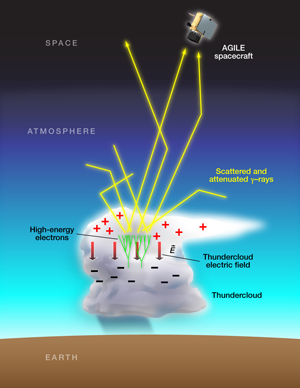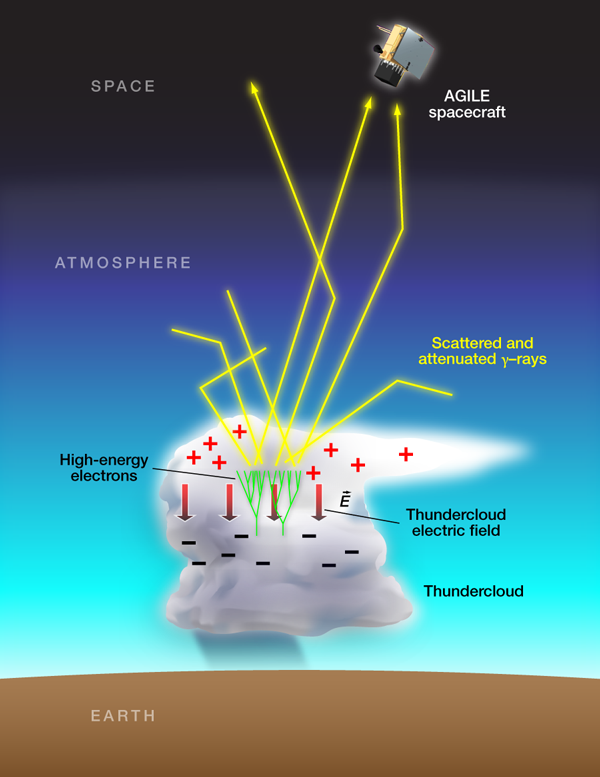Chance of thunder—and gamma-ray flashes
In a paper appearing in Physical Review Letters, scientists in Italy (Tavani et al.) present new space-based observations of gamma-ray emissions from thunderclouds, called terrestrial gamma-ray flashes (TGFs). Their analysis [1] suggests that storms located deep within our atmosphere sometimes produce bursts of electrons with energies up to . Although the exact mechanism is still uncertain, these electrons are believed to be accelerated by strong electric fields within the thunderclouds. As the energetic electrons propagate through air, they emit bremsstrahlung photons, which can then be observed hundreds of kilometers away by spacecraft. The new observations, which were made by the Italian Space Agency’s AGILE spacecraft, show for the first time the remarkable extent of the terrestrial gamma-ray flash energy spectrum [1]. Understanding how thunderstorms are able to produce such energetic gamma rays should tell us more about the electrical environment inside these storms and what conditions are present during lightning initiation—questions that continue to confound us even 250 years after Benjamin Franklin’s kite experiment.
The most well-known particle accelerators are man-made facilities, like the Large Hadron Collider at CERN, or natural accelerators, such as supernova explosions, coronal mass ejections, or solar flares. In all of these cases, the subatomic particles are accelerated in partial vacuum. As a result, the fact that thunderclouds, located deep in our atmosphere, are powerful particle accelerators may seem counterintuitive. However, we now know that thunderclouds, and even lightning, can generate very high-energy electrons, positrons, x rays, and gamma rays. Since x rays and gamma rays usually travel much farther through our atmosphere than the electrons and positrons that produced them, these atmospheric particle accelerators are most often studied remotely by measuring the emitted energetic radiation. For example, x rays up to a few have been measured from natural and rocket-triggered lightning [2,3], and surges of gamma rays lasting several seconds have been occasionally observed from thunderclouds [4].
One fascinating class of events are bright, millisecond-long bursts of gamma rays called terrestrial gamma-ray flashes or TGFs, which the BATSE instrument onboard the Compton Gamma-ray Observatory (CGRO) first discovered in the early nineties [5]. Initially, most researchers believed the flashes originated from high-altitude discharges called sprites. Recently, however, several independent lines of research have shown that the source of TGFs is actually thunderstorms (Fig. 1), much lower in our atmosphere [6,7]. Interestingly, this places the source of TGFs, with their large fluxes of high-energy radiation, at about the same altitudes that commercial aircraft routinely fly, raising the concern of potential radiation hazards to individuals in aircraft [8].
It is generally accepted that the gamma rays in TGFs come from the bremsstrahlung radiation of energetic electrons interacting with air. The electrons are produced by the relativistic runaway electron avalanche mechanism (sometimes referred to as runaway breakdown). Inside thunderclouds, the electric fields can grow large enough that the rate that fast electrons gain energy from the field is larger than the rate with which they lose energy interacting with molecules in the air. Such electrons can acquire large energies from the electric field and are said to “run away.” As the runaway electrons travel through air, they sometimes undergo hard elastic scattering with atomic electrons, producing additional electrons that can also run away. The result is an avalanche of high-energy electrons that grow exponentially in number with distance [9]. Because the energy gain of the runaway electrons is closely tied to the avalanche growth rate, the energy spectrum of runaway electrons is expected to be exponentially decreasing with an -folding energy of about that is, the energy spectrum varies as , independent of the air density, humidity, precipitation, or details about the electric field. However, the total potential difference inside the storm and the electric field strength ultimately limit the maximum electron energy.
Up until now, detailed measurements of the energy spectrum have been limited. For example, CGRO/BATSE had only four energy channels in its detector that extended up to a few hundred keV. The RHESSI spacecraft measured many important properties of TGFs but could only measure energies up to [6]. More recently, FERMI/GBM has found some gamma rays reach [10]. The Mini-Calorimeter detector (MCAL) onboard the AGILE satellite measures gamma rays from all directions in the – range, making it very well suited for measuring TGFs. The new AGILE/MCAL data reported by Tavani et al., remarkably, show that the energy spectrum of electrons in TGFs extends up to . Right off the bat, this shows that very large potential differences must be present inside the storms. Surprisingly, no one knows what potential differences thunderstorms are capable of producing. The difficulty is that the required multipoint electric field observations are extremely challenging to make. When taking into account the energy losses of the electrons in air, the observation that the spectrum extends to means that thunderstorms may be achieving several hundred million volts of potential difference with a moderately strong electric field—an unexpected electrical property of these storms. Even more interesting, the TGF spectrum reported by Tavani et al. deviates significantly from an exponential at the highest energies, becoming a power law. This observation will be very challenging to explain using the standard relativistic runaway electron avalanche model, and it is possible that some other mechanisms are also involved in the production of TGFs. However, this will leave theoreticians scratching their heads, since it is not obvious what other mechanisms are even capable of accelerating particles to such high energies inside thunderstorms.
References
- M. Tavani et al., Phys. Rev. Lett. 106, 018501 (2011)
- C. B. Moore, K. B. Eack, G. D. Aulich, and W. Rison, Geophys. Res. Lett. 28, 2141 (2001)
- J. R. Dwyer, M. A. Uman, H. K. Rassoul, M. Al-Dayeh, E. L. Caraway, J. Jerauld, V. A. Rakov, D. M. Jordan, K. J. Rambo, V. Corbin, and B. Wright, Science 299, 694 (2003)
- H. Tsuchiya et al., Phys. Rev. Lett. 99, 165002 (2007)
- G. J. Fishman et al., Science 264, 1313 (1994)
- J. R. Dwyer and D. M. Smith, Geophys. Res. Lett. 32, L22804 (2005)
- S. A. Cummer, Y. Zhai, W. Hu, D. M. Smith, L. I. Lopez, and M. A. Stanley, Geophys. Res. Lett. 32, L08811 (2005)
- J. R. Dwyer, D. M. Smith, M. A. Uman, Z. Saleh, B. Grefenstette, B. Hazelton, and H. K. Rassoul, J. Geophys. Res. 115, D09206 (2010)
- A. V. Gurevich, G. M. Milikh, and R. Roussel-Dupré, Phys. Lett. A 165, 463 (1992)
- M. S. Briggs et al., J. Geophys. Res. 115, A07323 (2010)





